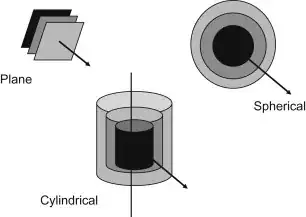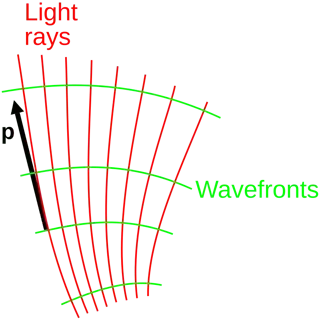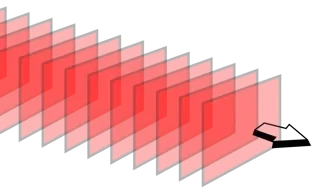According to Faraday's law of induction and Ampere's law, a changing magnetic field causes curl of electric field simultaneously; and also a changing electric field causes curl of magnetic field simultaneously. By combining these equations, the equation of electromagnetic wave is derived. I thought I understood completely until I realize I didn't get how the light travels straight line if one causes curl of another. I saw visualization of electromagnetic wave but still it looks like violating faraday law and Ampere law.
- 143
4 Answers
From the Maxwell's equation you can derive the wave equation, whose solutions are a propagating wave. Next, we need to define what is meant by propagation direction of the wave, and then look to see if it is, in fact, propagating along a straight line.
In the classic textbook examples, one assumes
- free-space propagation
- A single frequency, f, of the wave to simplify the time-dependent derivative term.
From the above, you end up with a simple ordinary differential equation that just depends on the spatial coordinates.
Next, look for plane wave solutions of the form: Exp[-i K x]. So, this gives rise to the notion of phase (or wave) front, and we can assign a wavevector (K) to this front that is orthogonal to E and B, but is parallel to the propagation direction. From here we can see that these plane wave solutions travel in straight lines.
The electromagnetic wave equation allows for plane wave solutions in the form of
$$ \vec{u}=\vec{u_0}\exp(i\vec{k}\cdot\vec{r}-\omega t), $$
and since the wave vector can always be chosen to travel in a single direction (by defining our reference frame conveniently), one can always rewrite $\vec{k}\cdot\vec{r}=kz$ (choosing $\vec{k}=(0,0,k)$). Then, it's clear that the waves propagate in the $z$ direction - in one direction. But these are not the only possible solutions. Other solutions may propagate as spherical waves, in all directions.
- 4,386
With the setup as shown in the figure the light does not propagate in a straight line - the setup is cylindrically symmetric, and the resulting wave is a cylidnrical wave... looking rather different from a plane wave, which is usually used to explain waves (image source):

Plane wave does not travel along a straight line either - it does have a specific direction, characterized by its wave vector, which is perpendicular to the planes of equal phase, which extend into infinity. Note however, that when spherical, cylindrical or other wave are viewed from a distance, plane wave serves as a good approximation for practical purposes, i.e., the curvature is too small and can be neglected.
For practical purposes one can sometimes discuss waves in terms of rays, i.e., the lines that are traced by a wave vector. In other words, we replace mentally an infinite number of infinite planes of equal phase by an infinite number of lines piercing these planes. Each such line/ray is not a wave in itself, but the multitude of them is (see Ray (optics)):

See also Geometrical optics:

- 68,984
It is enough to realize that accelerated electrons on an antenna rod emit photons. The radioelectrician doesn't really care, the physicist should base his considerations on it.
These photons are polarized with their electric field along the rod axis and perpendicular to it (and perpendicular to the direction of propagation of the photon) with its magnetic field.
The number of emitted photons is a multiple of the number of emitting electrons, the emissions periodically rise and fall and change sign. The macroscopic electromagnetic wave, which Hertz has already measured, is therefore based on the frequency of the wave generator and consists of polarized photons in periodically decreasing and increasing numbers.
Your picture describes the mechanism of the movement of each individual photon. The decaying electric field of the photon passes along the direction of propagation into a magnetic field and this in turn into an electric field - this time in the opposite direction. Self-induction with energy conservation - nature is clever. As the rod antenna is not a directional antenna, this happens evenly in all horizontal directions.
TL;DR If you are far enough away from the antenna, you will reach a point where you only receive single photons. You can deduce a radio source from the periodicity of the reception. That's what radio astronomers do, among other things. TL;DR
- 10,980